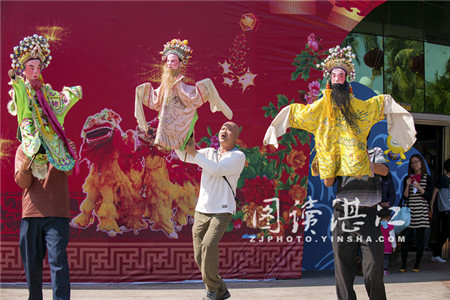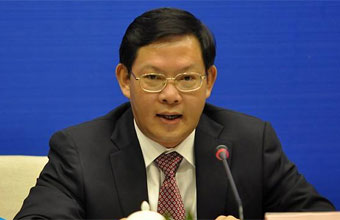Home> Arts and Traditions
Puppets brought to life in Wuchuan
For puppeteers on Zhanjiang's Wuchuan, the ancient lanes, alleyways, and courtyards provide the stage and setting for their performances.
The traditional folk music hanging in the air, the puppets, decorated to look like characters from history, myth, and legend act out stories to audiences who have been delighted by the art form for centuries.
 |
An artist performs a puppet show in Wuchuan, Zhanjiang. [Photo by He Zhaoming, Huang Xiaoyu/gdzjdaily.com] |
Delicately handcrafted puppets, both small and large, are manipulated by master puppeteers using three thin rods, attached to the head, arms, and legs. The rods allow the puppeteers a great breadth of movement, performing, jumps, dances, tumbles, and even intricate flashes of the eyes and mouth.
For more than 400 years, Wuchuan has produced some of the finest and most talented puppeteers in Guangdong, adapting ancient novels and opera into the Wuchuan dialect and giving them new life through their art. Using a seven-word structure, the singers sing using oblique tones to sound more like traditional folk songs.
The fundamental traits of Peking Opera, such as singing, speech, and combat are all required in a puppeteer in order for him or her to achieve mastery in the art form.
 |
| Wuchuan puppetry troupe stages a performance at a folk art festival in 2014. [Photo/zjphoto.yinsha.com] |
"When performing, we have to lift the puppets with rods, each puppet alone weighs about 1.5 kilograms and shows of two or three hours can be extremely exhausting," said Luo Guanlai, a master puppeteer from Zhanjiang.
An indispensible part of any puppeteer troupe is having a top notch band, capable of performing at the highest level with traditional Chinese instruments. Props, costumes, refined staging and arrangements have all made great advances over the years, with some of the latest puppets able to bleed on demand during extravagant fight scenes.
 |
An artist manipulates a puppet while singing a traditional song. [Photo/zjphoto.yinsha.com] |
The art form is still widely practiced throughout Zhanjiang to this day, and has been recognized as a valuable cultural legacy under the protection of the provincial government.

 Print
Print Mail
Mail 5G construction supports Zhanjiang's high-quality development
5G construction supports Zhanjiang's high-quality development
 Acting mayor inspects project construction in Xuwen, Leizhou
Acting mayor inspects project construction in Xuwen, Leizhou Zhanjiang island an "egret paradise"
Zhanjiang island an "egret paradise"  Dancing egrets add vitality to Xiashan
Dancing egrets add vitality to Xiashan